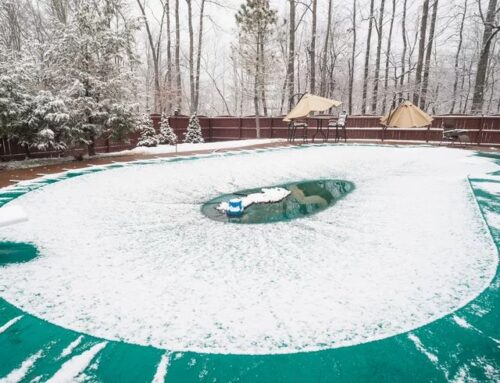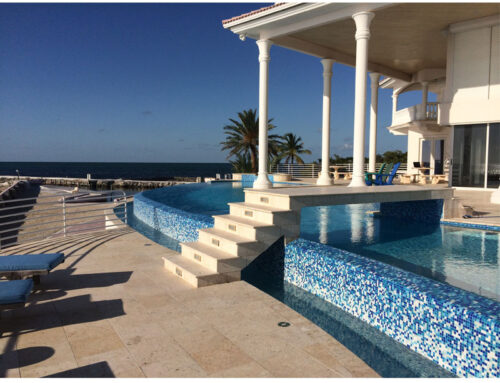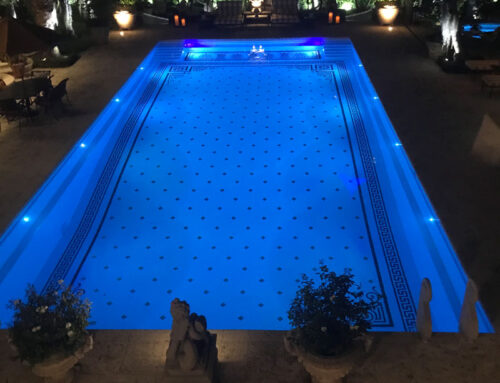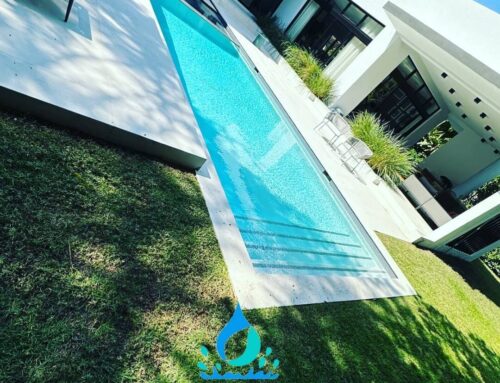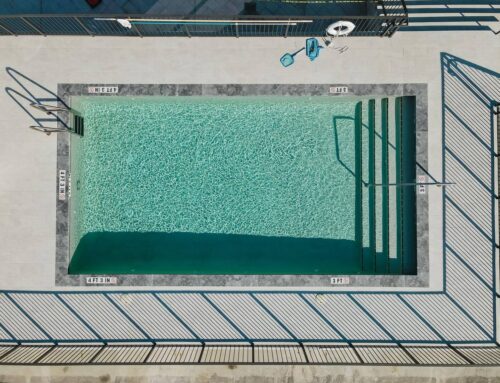If you’re thinking about installing or remodeling a pool, you should think about pool decking as much as you think about the shape and size. The way your pool looks and the entire atmosphere around it mostly depends on your choice of the pool deck. You’d be surprised just how big of a difference one choice of deck can make over another.
Moreover, if you select the wrong deck for your yard, you’ll have to deal with pool repairs much more often than you otherwise would. So, it’s a good idea to learn about pool decks and get some pool deck ideas before you get started on your journey.
This article will be your complete guide to pool decks, and you’ll find everything you need to know to pick the perfect one for your yard.
Pool Deck Basics – Decking vs. Coping
Pool decking is often confused with pool coping. While related, these two terms shouldn’t be mixed up because it can lead to misunderstanding between you and your pool contractor. In the context of pools, coping is the material used to cap the edge of the pool. That is to say, the top of the pool wall. The point of the coping is to separate your pool from the surrounding area.
Decking, on the other hand, is the immediate area around the pool. That’s where you’d put your pool chairs, parasols, and other furniture.
Both coping and decking have a huge impact on your pool’s appearance, but each affects it in a slightly different way. Coping usually encompasses no more than 12 inches around the pool, and it’s typically made of stone or concrete. Decking gives you a lot more freedom, and you can really add character to your entire yard with the right decking.
Decking Materials
The most important consideration when it comes to pool decking is the material that you’ll use. Some materials give a more modern and contemporary look, such as concrete, whereas others will make your pool look more traditional, such as stone or wood.
Concrete Decking
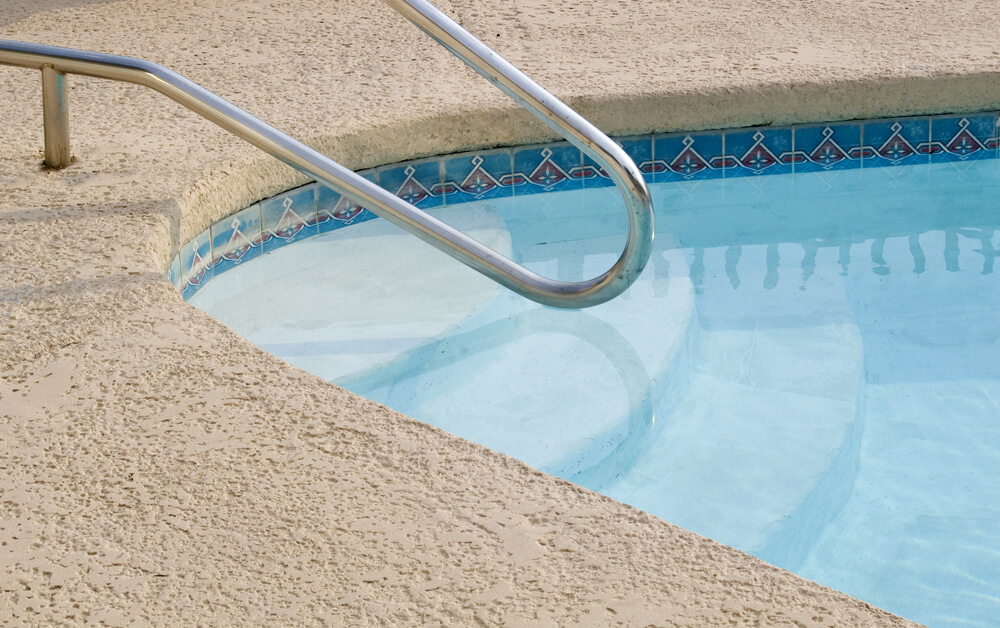
Concrete is the most basic option for a pool deck. But, it’s also supremely versatile and durable. The main reason concrete makes a good decking material is its affordability. It’s one of the most inexpensive options for a pool deck, with broom-finished concrete being the most inexpensive by far. Another important benefit of concrete is that it gives you a lot of flexibility in terms of style options.
Pool decks made of concrete aren’t necessarily plain and simple. You’ll have a choice between several finishing techniques, such as stamped concrete and textured concrete.
Stamped concrete is particularly versatile because it combines the affordability of concrete while offering the elegance of stone pavers or any other appearance. In that way, concrete can imitate a lot of other materials, even wood, to some extent. Natural stones are an excellent and beautiful choice for decking, but their price is often a limiting factor.
The one big drawback of a concrete deck is that cracks will eventually form. There’s not much you can do about this, but there are some methods to control it. A Florida pool and spa that’s exposed to sunlight year-round is especially susceptible to cracking. Another minor inconvenience comes from stamped concrete. Stamped concrete tends to be slick and smooth and can become slippery when wet. Since it’s going to be wet a lot of the time, that’s a hazard you might want to consider if you expect small children to use the pool.
Wood Decking
In design circles, there’s an axiom that says wood goes with everything. And, to some extent, that’s true. Wood is a timeless classic in any setting, and it’s a fantastic choice for a pool deck for a lot of reasons.
First and foremost, wood gives your pool a pleasing appearance overall. Most people enjoy the look of wood, and it’s probably the best choice for above ground pool deck ideas. Wood is also very comfortable to walk on. Some research even shows that just making contact with wooden surfaces can relax people. Furthermore, wood comes in a lot of different styles, grains, colors, and patterns.
However, everything comes at a price, and the price of a wood deck is pretty steep. It’s among the more expensive options in terms of dollars per square foot. Wood is also among the most difficult surfaces to maintain in the long term. You’ll need to do an awful lot of preventive and proactive maintenance. It will need to be stained and sealed regularly, and that’s a big job if you have a large deck. And, like stamped concrete, wood can get quite slippery. You can seal it with fine aggregate to prevent this from happening, but that’s yet another added cost.
But, you’ll be happy to know that there’s a middle ground. Composite wood gives the appearance of wood and most of the benefits while still being easy and simple to maintain. Composite wood is made of synthetic materials, which makes it extremely durable and resilient. It also comes in a wide variety of simulated wood types and grains. Be aware, though, that composite wood is quite expensive. It’s even more expensive than traditional wood, so you get a premium surface, but you also pay a premium price.
Stone Decking
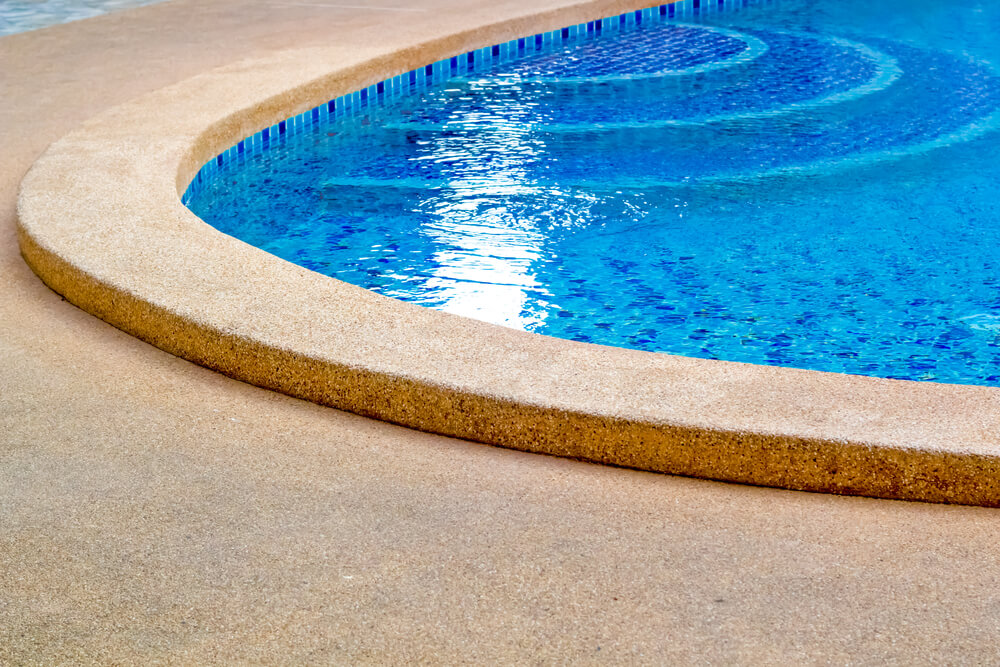
The first building material used by man is still used today and no wonder. Stone is as durable as it is attractive, and it’s available everywhere. The main advantage of stone is how good it looks. It’s one of the most widely used materials in pool decking because it makes a powerful statement. It also lasts forever. The stones that end up on your pool deck might have already been around for millions of years, so there’s no reason not to expect them to last for your pool’s entire lifetime. Moreover, the shape and size of stones can be customized to create intricate patterns in your deck surface. And, stones provide a naturally textured surface, so there’s a reduced risk of slipping, even when the stones are wet.
Now, there’s a bit of a caveat about stones. While they’re available anywhere, not all types of stones are available in all locations. If you want a specific kind of stone for your deck, you might have to get it shipped from far away. That can, and will, add substantially to the final price of the deck. Furthermore, if you need to do pool repairs on your deck, you’ll want to match the stones that are already in place. If you chose a special type of stone, that would mean another added expense.
Overall, stone is going to be the most expensive option, no matter what type you choose. But, you’ll have a beautiful surface that lasts forever.
Paved Decking
Pavers are a good alternative to stone that retain a lot of the same properties. Stone pavers, especially, are a good way to get a good-looking deck without the extreme price. However, concrete pavers are a lot more affordable and available. Concrete pavers are superior to poured concrete in a few ways. While poured concrete is cured at the site where it’s poured, pavers are cured before they’re placed. This makes them much less likely to crack. Additionally, the fact that pavers are small units of concrete makes it even more difficult for them to crack. Each paver has the freedom to shift slightly instead of being one large, inelastic surface.
Pavers also give you a lot of freedom to customize them with the design you want. By mixing and matching colors and arrangements, you can achieve a lot of different styles. Concrete pavers are slightly more expensive than poured concrete. However, many people will find that it’s worth it to have less maintenance and more durability.
Tile Decking

Finally, there’s tile. Tile is easy to work with, modestly priced, and provides a clean and symmetrical appearance. You should note that only an unglazed tile can be used for a pool deck. Glazed tiles are far too smooth and slippery for the purpose.
When most people hear tile, their mind immediately goes to the square tiles in bathrooms and kitchens. But there’s no reason to limit yourself to square tiles. They come in a variety of shapes, colors, and sizes. You’d be surprised at just how much customization you can get out of a tile deck. It’s also one of the easiest deck materials to work with. An experienced work crew can set a tile deck in as little as a few days. And, tiles can be placed on top of most other surfaces, such as concrete.
Tile isn’t especially durable, but they’re self-contained units. If a tile cracks, it’s easy enough to replace it without disturbing the tiles around it. Even if you need to resurface the entire deck, tiles can cup off easily and be replaced entirely.
Is It Time for a New Deck?
If your pool is starting to show its age, or if you’re just ready for a new look, replacing the deck is an excellent way to breathe new life into any pool. With so many material options to choose from, you can have a pool that both looks great and meets all your needs.
Whether you want an entirely new pool or you want to remodel the one you have, we’ve got you covered at Florida Pool & Patio. We provide construction and design services for pools and spas of all types. If you’re looking for more tips on choosing the right kind of pool deck, call us today to speak with one of our experts.


